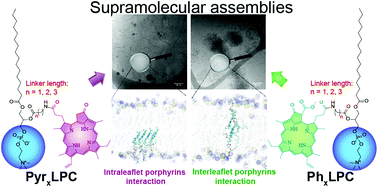Phospholipid–porphyrin conjugates: deciphering the driving forces behind their supramolecular assemblies†
Abstract
Phospholipid–porphyrin conjugates (PL–Por) are nowadays considered as a unique class of building blocks that can self-assemble into supramolecular structures that possess multifunctional properties and enhanced optoelectronics characteristics compared to their disassembled counterparts. However, despite their versatile properties, little is known about the impact of the packing parameter of PL–Por conjugates on their assembling mechanism and their molecular organization inside these assemblies. To gain a better understanding on their assembling properties, we synthesized two new series of PL–Por conjugates with different alkyl sn2-chain lengths linked via an amide bond to either pheophorbide-a (PhxLPC) or pyropheophorbide-a (PyrxLPC). By combining a variety of experimental techniques with molecular dynamics (MD) simulations, we investigated both the assembling and optical properties of the PL–Por either self-assembled or when incorporated into lipid bilayers. We demonstrated that independently of the linker length, PhxLPC assembled into closed ovoid structures, whereas PyrxLPC formed rigid open sheets. Interestingly, PyrxLPC assemblies displayed a significant red shift and narrowing of the Q-band indicating the formation of ordered J-aggregates. The MD simulations highlighted the central role of the interaction between porphyrin cores rather than the length difference between the two phospholipid chains in controlling the structure of the lipid bilayer membranes and thus their optical properties. Indeed, while PhxLPC have the tendency to form inter-leaflet π-stacked dimers, PyrxLPC conjugates formed dimers within the same leaflet. Altogether, this work could be used as guidelines for the design of new PL–Por conjugates that self-assemble into bilayer-like supramolecular structures with tunable morphology and optical properties.



 Please wait while we load your content...
Please wait while we load your content...